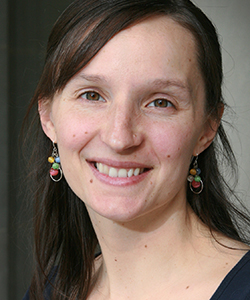Research has clearly demonstrated that the conditions under which teachers work affect the ability to retain those teachers and the academic outcomes of their students.

But are researchers using the same definitions when they examine teacher working conditions?
No, says Becca Merrill.
Merrill, a 2019 doctoral graduate of the School of Education, conducted a review of the literature examining teacher working conditions, determining that definitions of those conditions varied widely among the studies, making it difficult to compare findings regarding the environments in which educators work. The study, conducted for her dissertation and apparently the first of its kind, has been published in Review of Educational Research, a leading journal of the American Educational Research Association.
Merrill, who earned her doctorate in the Policy, Leadership and School Improvement strand of the Ph.D. program and now works as a researcher at Education Northwest, an educational research and consultancy based in Portland, Oregon, said she was motivated by personal experience to research the working conditions of teachers.
“As a former teacher, I focused on some of the things that drove me out of the classroom, namely low pay and difficult working conditions,” she said. “As I began to study teacher working conditions in more depth, I quickly saw that each researcher defined teacher working conditions in their own, often diverse, way.”
Developing a framework
Merrill said she realized that without a common understanding of the working conditions being examined by researchers it would be difficult for policymakers or school leaders to make sense of the varying definitions and to implement suggested improvements identified in the studies.
“Teacher working conditions, the flipside of student learning conditions, are too important to be overlooked,” Merrill said. “So, I decided to synthesize across the extant research literature to configure a narrative definition of teacher working conditions, inventory what they are, and demarcate what they are not.”
Merrill BC. Configuring a Construct Definition of Teacher Working Conditions in the United States: A Systematic Narrative Review of Researcher Concepts. Review of Educational Research. January 2021.
Merrill’s study outlines a framework that categorizes an expansive set of working condition factors into 12 categories. That framework of definitions is intended to set parameters that can help align future studies of teacher working conditions, Merrill said. The framework also should serve to help guide data gathering methods that collect data that are more directly tied to factors that school leaders and policymakers can change to improve outcomes, she said.
“I hope the work will help researchers, policymakers, school leaders, and teachers speak the same language about teacher working conditions, paving the way for fruitful conversations and understandings,” Merrill said.
The 12 categories of teacher working conditions
Merrill’s review started with a review of 7,326 articles found from database searches. A series of reviews to exclude studies that do not examine working conditions, and to remove duplicates and studies outside the United States, resulted in a final list of 81 studies.
Analyzing the content of those studies, Merrill was able to categorize included working conditions into 12 categories:
-
• Leadership and teacher empowerment
• Students
• Faculty
• District, state, and national actors
• Parents and community
• General and instructional resources
• Orientation/climate
• Professional development
• Time
• School features
• Facilities
• Safety
Lora Cohen-Vogel, the Frank A. Daniels, Jr. Distinguished Professor and Merrill’s doctoral program advisor, said Merrill’s work makes an important contribution.
“Having worked as a graduate research assistant with me to conceptualize studies from the ground up, Becca quickly understood that the literature on teacher working conditions was highly disorganized and lacked an orienting framework,” Cohen-Vogel said. “Independently and ambitiously, she set out to correct this.
“The resulting framework not only defines for the field what’s meant by the conditions of teachers work, but also connects those conditions to teacher retention and student outcomes,” Cohen-Vogel said.
In her paper, Merrill said researchers have demonstrated that teacher working conditions are important, but the field has not developed an effective way of studying them that facilitates research aimed at improving schools.
“I hope this framework will orient future researchers to focus more narrowly on teacher working conditions,” Merrill said. “I also urge for the development of directive measures of teacher working conditions, which are measures that imply a remedial action that can be taken by policymakers and school leaders and advocated for by teachers.”